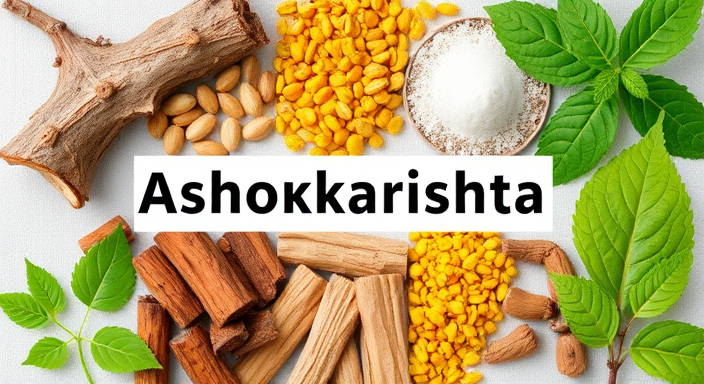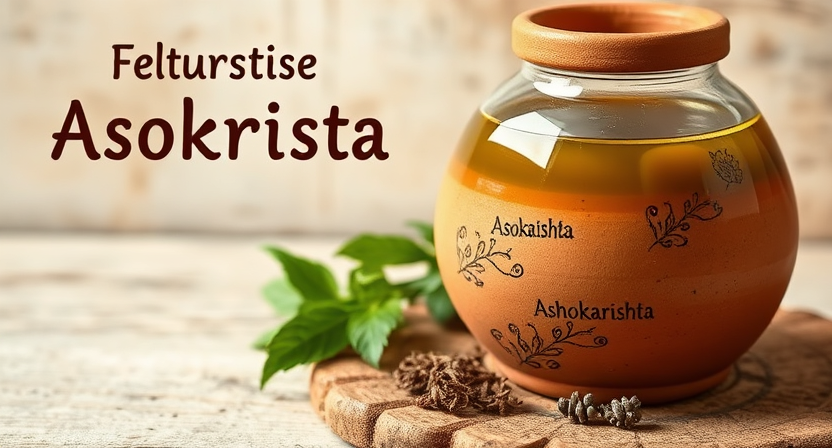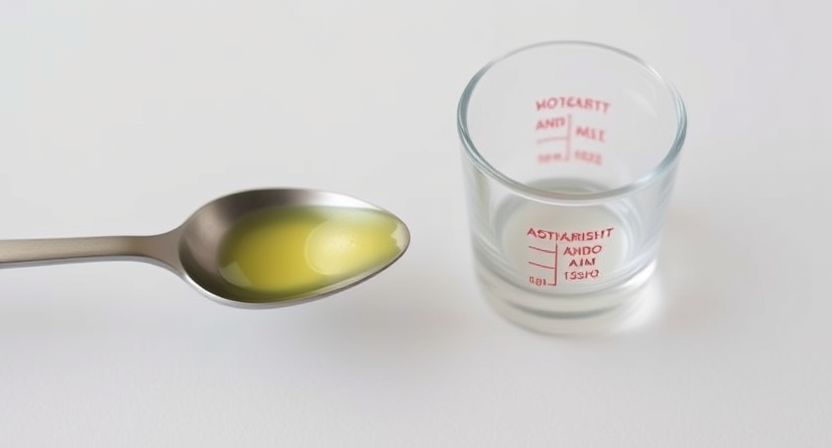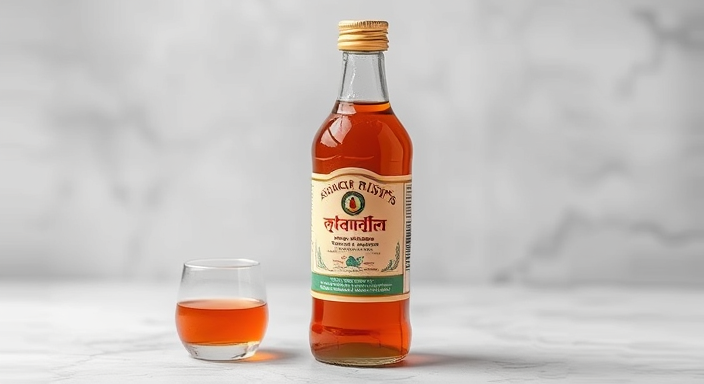This Content Is Only For Subscribers
Ashokarishta: Introduction
Ashokarishta, a traditional Ayurvedic liquid formulation, holds a prominent position in the realm of women’s health within the ancient Indian system of medicine. Classified as an arishta, it is a self-generated alcoholic preparation made through a process of fermentation. This specific formulation is renowned for its use in addressing a variety of gynecological issues, particularly those related to menstrual irregularities and uterine health.

Ashokarishta is not merely a simple herbal concoction; it is a sophisticated combination of natural ingredients, carefully selected and combined to achieve specific therapeutic outcomes. This article aims to provide an in-depth exploration of Ashokarishta, covering its composition, traditional applications, dosage guidelines, potential side effects, necessary precautions, and any relevant modern perspectives. The aim is to offer a balanced view informed by both traditional understanding and contemporary insights.
Table of Contents
Ingredients: The Components of Ashokarishta
Ashokarishta is a carefully crafted formulation, comprising various herbs, spices, and other natural components that work synergistically to achieve its therapeutic effects. Here’s a detailed breakdown of its primary ingredients, including their common names, botanical names, and their traditional Ayurvedic properties:

| Ingredient (Common Name) | Botanical Name | Ayurvedic Properties (Rasa, Guna, Virya, Vipaka) | Purported Role in Formulation |
| Ashoka (Saraca indica) | Saraca asoca | Kashaya, Tikta, Ruksha, Sheeta, Katu | Uterine tonic, reduces excessive bleeding, anti-inflammatory, analgesic |
| Dhataki Flower | Woodfordia fruticosa | Kashaya, Ruksha, Sheeta, Katu | Facilitates fermentation, imparts color, contains tannins |
| Amalaki (Indian Gooseberry) | Emblica officinalis | Amla, Madhura, Sheeta, Laghu, Madhura | Rich in Vitamin C, antioxidant, rejuvenative, immunomodulatory, supports overall well-being, balances Pitta |
| Bibhitaki (Belleric Myrobalan) | Terminalia bellirica | Kashaya, Tikta, Ruksha, Ushna, Madhura | Supports digestion, expectorant, rejuvenative, balances Kapha and Pitta |
| Haritaki (Chebulic Myrobalan) | Terminalia chebula | Tikta, Kashaya, Ruksha, Ushna, Madhura | Digestive, laxative, detoxifier, rejuvenative, supports overall health |
| Shunthi (Dry Ginger) | Zingiber officinale | Katu, Ushna, Guru, Madhura | Digestive, carminative, anti-inflammatory, reduces pain and bloating |
| Musta (Nutgrass) | Cyperus rotundus | Katu, Tikta, Ruksha, Sheeta, Katu | Digestive, carminative, anti-inflammatory, reduces fever |
| Daruharidra (Indian Barberry) | Berberis aristata | Tikta, Katu, Ruksha, Ushna, Katu | Anti-inflammatory, anti-microbial, blood purifier, supports liver function |
| Utpala (Blue Lotus) | Nymphaea stellata | Madhura, Kashaya, Laghu, Sheeta, Madhura | Cooling, anti-inflammatory, soothing, reduces burning sensation, promotes overall health |
| Amrasthi (Mango Seed Kernel) | Mangifera indica | Kashaya, Ruksha, Sheeta, Katu | Astringent, styptic, reduces excessive bleeding, improves digestion |
| Jeeraka (Cumin) | Cuminum cyminum | Katu, Laghu, Ushna, Katu | Digestive, carminative, reduces bloating and gas |
| Guda (Jaggery) | Saccharum officinarum | Madhura, Guru, Ushna, Madhura | Sweetening agent, base for fermentation |
| Jal (Water) | Aqua | Sheeta,Laghu | Base for the preparation |
Top 10 Benefits and Uses of Ashokarishta
| # | Benefit/Use | Description | Ayurvedic Principle/Basis |
| 1 | Regulates Menstrual Cycles | Helps to normalize irregular menstrual cycles, making them more regular and balanced; addresses both oligomenorrhea (scanty flow) and menorrhagia (excessive flow). | Balances Vata and Pitta doshas, promotes Artava (menstrual flow) regularity. |
| 2 | Reduces Menorrhagia (Excessive Bleeding) | Effectively manages heavy menstrual bleeding, reducing excessive flow due to its astringent and hemostatic properties and also promotes healing of uterine tissues. | Strengthens uterine muscles, reduces Rakta Pitta (bleeding disorders) |
| 3 | Alleviates Dysmenorrhea (Painful Periods) | Provides relief from menstrual cramps and abdominal pain associated with menstruation due to its analgesic and anti-inflammatory properties. | Balances Vata and reduces pain due to inflammation (Shoola hara). |
| 4 | Supports Uterine Health | Acts as a uterine tonic, strengthening the uterine muscles, promoting overall uterine health, reducing uterine inflammation, and improving uterine tone. | Improves the overall health and functionality of the uterus, supports Garbhashaya (uterus) health. |
| 5 | Manages Leukorrhea (White Discharge) | Helps manage excessive white discharge by balancing vaginal secretions and treating any underlying infections that may be causing the discharge. | Balances Kapha and reduces excessive vaginal secretions. |
| 6 | Improves Digestive Health | Enhances digestion and reduces digestive discomfort that often occurs during the menstrual cycle, such as bloating and gas. | Improves Agni (digestive fire), reduces Ama (toxins) related to digestion. |
| 7 | Reduces Inflammation | The anti-inflammatory properties of the herbs help to reduce inflammation in the pelvic region, which may help to relieve other associated discomforts, specifically during menstruation. | Shotha hara properties of ingredients, particularly Ashoka and Musta. |
| 8 | Provides Antioxidant Support | Rich in antioxidants due to ingredients like Amalaki, this helps to protect against cellular damage and promote overall health. | Rich in Amla Rasa ingredients that provide Rasayana (rejuvenative) and antioxidant properties. |
| 9 | Improves Overall Well-being | Acts as a general tonic, providing energy, reducing fatigue, and supporting overall health and vitality, especially for women during reproductive years. | Strengthens Rasa and Rakta dhatu (body tissues), promotes overall Ojas (vitality). |
| 10 | Rejuvenative Support | The formula is considered a rejuvenating and nutritive tonic that can enhance overall vitality in women. | Promotes Rasayana and provides nourishment, improving overall health and stamina. |
Important Notes:
- Women’s Health Focus: These benefits and uses are specifically focused on the traditional application of Ashokarishta in women’s health, particularly related to menstrual issues.
- Traditional Perspective: The information is based on traditional Ayurvedic principles and practices.
- Individual Variability: The effectiveness of Ashokarishta may vary based on an individual’s Prakriti, health status, and other factors.
- Not a Primary Treatment: It’s typically used as a supportive remedy, not as a primary treatment for severe conditions.
- Professional Guidance: Always seek the advice of a qualified Ayurvedic practitioner or healthcare provider before use.
- Limited Modern Research: Modern scientific evidence specifically on Ashokarishta is limited; effects are often based on traditional use and properties of its individual ingredients.
Understanding Ayurvedic Properties
The Ayurvedic properties (Rasa, Guna, Virya, and Vipaka) are crucial in understanding the function and impact of each ingredient and the overall formulation of Ashokarishta:
- Rasa (Taste): This describes the taste of an ingredient – such as Madhura, Katu, Tikta, Kashaya, Amla, or Lavana.
- Guna (Qualities): This refers to attributes like Guru, Laghu, Sheeta, Ushna, Ruksha, or Snigdha.
- Virya (Potency): Describes whether an ingredient has a heating or cooling effect.
- Vipaka (Post-Digestive Effect): Defines the effect of an ingredient after digestion, which could be Madhura, Amla, or Katu.
The specific combination of these properties in Ashokarishta works to balance the doshas, particularly Pitta and Vata, supporting optimal gynecological health by addressing the imbalances that can lead to menstrual disorders.
Source and Quality of Ingredients
The effectiveness of Ashokarishta is greatly dependent on the quality of its ingredients. Traditionally, herbs are collected from their natural habitats at their optimal time for maximum potency. In modern times, manufacturers often source cultivated herbs, which can be equally effective if managed properly.
The quality and authenticity of jaggery and Dhataki flowers should also be ensured. Quality control should be strictly adhered to, and the use of genuine and unadulterated herbs is essential for this formulation.
Traditional Uses of Ashokarishta
Ayurvedic texts, including Bhaishajya Ratnavali, Charaka Samhita, and Susruta Samhita, outline the traditional uses of Ashokarishta. It is highly regarded for its ability to:

- Regulate Menstrual Cycles: It helps in normalizing irregular menstrual cycles, making them more regular and balanced, particularly during cases of oligomenorrhea and menorrhagia (scanty and excessive bleeding).
- Reduce Menorrhagia (Excessive Bleeding): It is a popular remedy for managing heavy menstrual bleeding, helping to reduce excessive flow due to its astringent and hemostatic properties.
- Alleviate Dysmenorrhea (Painful Periods): Its analgesic and anti-inflammatory properties help to reduce menstrual cramps and abdominal pain associated with menstruation.
- Support Uterine Health: It acts as a uterine tonic, strengthening the uterine muscles and promoting overall uterine health and tone, thus also addressing any bleeding disorders of the uterus.
- Manage Leukorrhea (White Discharge): It is used to manage excessive white discharge, helping to balance vaginal secretions.
- Improve Digestive Health: It also helps improve digestion and relieve digestive discomfort during menstrual cycle.
- Reduce Inflammation: The anti-inflammatory properties of the ingredients help to alleviate inflammatory conditions in the pelvic region.
- Rejuvenation and Overall Well-being: It is considered a rejuvenating tonic for women, improving overall health and stamina.
Ashokarishta is commonly prescribed as a supportive remedy in women’s health, particularly for menstrual issues, but it should be taken under the guidance of a qualified practitioner.
Primary vs. Secondary Uses
The primary focus of Ashokarishta is on managing menstrual irregularities and supporting uterine health. Its use as an anti-inflammatory, digestive aid, and as a general tonic can be considered as secondary benefits that support overall well-being of women.
Modern Perspectives: Limited Scientific Evidence
While Ashokarishta has a long history of traditional use, modern scientific research specifically focusing on the combined effect of this formulation is limited. However, some of its individual components have been studied: Ashoka bark has shown significant uterine tonic, anti-inflammatory, and analgesic properties in research.
Amalaki, Haritaki, and Bibhitaki have shown antioxidant, anti-inflammatory, and rejuvenative benefits in individual studies. Further research is necessary to evaluate the combined synergistic effect of the formulation as a whole, and to validate its traditional uses through clinical trials. Much of the current evidence available is largely anecdotal and based on traditional Ayurvedic knowledge.
Preparation Methods
Ashokarishta is prepared using a traditional fermentation process:

- Infusion: The herbs and spices are ground and mixed with jaggery and water.
- Fermentation: The mixture is placed in a suitable vessel and allowed to undergo natural fermentation. Dhataki flowers are usually added to facilitate this process.
- Maturation: The mixture is left for a specific period (usually several weeks to months) allowing the active constituents to be released.
- Straining and Bottling: After fermentation, the liquid is strained, filtered, and bottled for use.
- Quality Control: Standard procedures are followed during commercial production to ensure the quality of finished product.
This results in a self-generated alcoholic liquid with a characteristic flavor and the combined therapeutic properties of all the ingredients. Due to limited information available regarding proprietary manufacturing process, the above mentioned is generalized information of making aristas.
Dosage Guidelines
The recommended dosage of Ashokarishta is typically based on age, individual constitution (Prakriti), the specific condition being addressed, and the severity of the symptoms. General guidelines are:

- Adult Women: 10 to 20 ml (2-4 teaspoons) twice daily after meals, or as directed by an Ayurvedic practitioner.
- Specific Conditions: Dosage can be adjusted based on the individual’s symptoms. A higher dose may be advised for heavy bleeding, while a lower dose may be sufficient for general support.
Importance of Prakriti
Ayurveda considers the individual constitution (Prakriti) for the prescription. Individuals with Pitta constitution, may need lower doses since Ashokarishta may increase Pitta due to presence of hot herbs, while those with Kapha constitution may tolerate it better.
Dosage Forms
Ashokarishta is primarily available as a liquid that should be taken orally. It can be taken directly or diluted with a small amount of water. Some commercial formulations may also be available in capsule form.
Side Effects and Precautions
While generally considered safe for use when taken as directed, Ashokarishta can have potential side effects and require specific precautions:
- Digestive Upset: Overconsumption may lead to mild digestive disturbances, such as stomach upset or heartburn.
- Alcohol Content: As a fermented product, it contains alcohol, which is an important factor for those with alcohol sensitivity.
- Allergic Reactions: Individuals may be allergic to any of the ingredients.
- Drug Interactions: It may interact with certain medications, including hormonal therapies.
- Pregnancy and Breastfeeding: It is contraindicated in pregnancy and breastfeeding unless specifically advised by a doctor.
The Importance of Professional Consultation
It is crucial to seek advice from a qualified Ayurvedic practitioner before using Ashokarishta if:
- You have existing gynecological conditions or other health issues.
- You are currently taking other medications.
- You are pregnant or breastfeeding.
- You are unsure of your Prakriti or the correct dosage.
A healthcare professional can offer personalized recommendations and guidance.
Quality and Storage

When choosing Ashokarishta, always select products from reputable manufacturers that follow good manufacturing practices. Store the formulation in a cool, dark place away from direct sunlight and heat, preferably in a tightly sealed glass container. It should be consumed within the expiry date. Any noticeable changes in its appearance, odor, or consistency should be considered a warning sign.
Disclaimer
The information provided in this article is intended for educational purposes only and should not be interpreted as medical advice. The use of Ashokarishta should be under the guidance of a qualified healthcare professional. Self-treatment can be harmful and should be avoided.
Conclusion
Ashokarishta is a traditional Ayurvedic formulation, highly regarded for its use in managing menstrual irregularities and promoting uterine health in women. While traditional texts highlight its benefits, it is important to approach its use with caution, mindful of potential side effects, contraindications, and its alcohol content.
Consulting a qualified Ayurvedic practitioner or healthcare professional before beginning its use is of utmost importance. By following these precautions, one can harness the therapeutic benefits of Ashokarishta responsibly and safely.
FAQs About Ashokarishta
- What exactly is Ashokarishta, and what is it traditionally used for?
Ashokarishta is a traditional Ayurvedic liquid formulation (arishta) made through a fermentation process, primarily used to address various gynecological issues in women. It’s traditionally employed to regulate menstrual cycles, reduce heavy bleeding, alleviate menstrual pain, and support overall uterine health. - What are the main ingredients in Ashokarishta?
Key ingredients include Ashoka bark, Dhataki flower, Amalaki (Indian gooseberry), Bibhitaki, Haritaki, Shunthi (dry ginger), Musta (nutgrass), Daruharidra, Utpala (blue lotus), Amrasthi (mango seed kernel), Jeeraka (cumin), jaggery, and water. Each of these ingredients has specific therapeutic properties that contribute to the overall effectiveness of the formulation. - How does Ashokarishta help with menstrual problems?
Ashokarishta helps manage menstrual problems through a combination of actions. It helps to normalize irregular cycles, reduce excessive bleeding, alleviate painful cramps, and support overall uterine health. It works by balancing the doshas and by its astringent, anti-inflammatory and analgesic properties. - What is the recommended dosage of Ashokarishta?
The typical recommended adult dosage is 10 to 20 ml (2-4 teaspoons) twice daily after meals, or as directed by an Ayurvedic practitioner. The dosage may be adjusted based on individual needs and the severity of symptoms. - Are there any side effects associated with taking Ashokarishta?
Possible side effects include mild digestive upset, heartburn, or allergic reactions. It contains alcohol due to the fermentation process, which can be problematic for some. It’s important to follow the recommended dosage and consult a practitioner if side effects are experienced. - Who should NOT take Ashokarishta?
Ashokarishta is generally not recommended for pregnant or breastfeeding women unless specifically advised by a healthcare provider. It should also be avoided by individuals with known allergies to any of its ingredients and those with acute digestive issues. - Can Ashokarishta interact with other medications?
Yes, it is possible for Ashokarishta to interact with certain medications, especially hormonal therapies or blood thinners. It is crucial to consult with a healthcare professional or an Ayurvedic practitioner if you are taking any prescription medications. - How should Ashokarishta be stored to maintain its quality and effectiveness?
It should be stored in a cool, dark place away from direct sunlight and heat, preferably in a tightly sealed glass container. It should be used within the expiration date and best to refrigerate after opening. - Where can I purchase Ashokarishta, and how do I ensure its quality?
Purchase Ashokarishta from reputable Ayurvedic pharmacies or manufacturers that follow good manufacturing practices and adhere to strict quality control measures. Check the product for certifications, avoid products with artificial additives and always check the expiry date. - Is Ashokarishta a cure for all women’s health issues?
No, Ashokarishta is not a cure for all women’s health issues. It is a supportive remedy used in traditional Ayurveda to manage menstrual irregularities and promote overall uterine health. It’s essential to seek proper medical advice from a qualified healthcare professional for any specific medical conditions.
